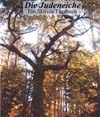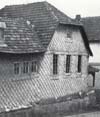Places
Rotenburg on the Fulda


Stolpersteine in Rotenburg an der Fulda
Right now we are devoting much of our time and energy to a project called "Stolpersteine" (=stumbling blocks) for former Jewish citizens of Rotenburg. So far we have been able to install 43 such memorial stones, each costing 120 €uro. We are confident we can find sufficient sponsors for more of them which are meant to honor and remember those who lost their lives in the Holocaust. Almost all of these victims do not have a gravesite. As some sort of compensation a concrete cube that is covered in brass with the name of the victim and his or her fate is installed into the sidewalk in front of the person’s last known residence. "Stolpersteine are a metaphor for the Germans stumbling over this part of their past—something that won't go away—and that was the artist's point," says James E. Young of the University of Massachusetts at Amherst, author of two books on Holocaust memorialization. "Stolpersteine don't exist in places where you have to make your pilgrimage. You suddenly come upon them." With the stolpersteine everybody sees that things happened in their neighborhood. They realize that there were people who lived in their house or even in their apartment." "It's very important not to lose the remembrance of this special part of German history.


Following Jewish Tracks in Rotenburg on the Fulda
A guided tour of the town invites to pay a virtual visit to some aspects of the varied history of Jewish Rotenburg. Here is hardly any other place in the state of Hessen on which a higher formative Jewish influence can be found. This is the result of Rotenburg, with short interruptions, being a place of Jewish settlement from ca. 1300 and having one of the largest Jewish small-town congregations. The CD-ROM version can be ordered postage-free with the address givenin the masthead of the website.

The Rotenburg Jewish Cemetery
Information is given about Jewish burial rites and about all 346 tombs. The oldest tombstone dates from 1743. The cemetery, however, was set up in the century before, the oldest evidence is of 1682. Up to the late 19th century the Rotenburg Jewish cemetery served as central burial site for the Jews from a number of neighbouring Jewish places, such as Baumbach, Bebra, Breitenbach, Iba, Lispenhausen, Ronshausen, and partly, Rengshausen.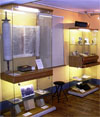
Jewish Museum in the former Rotenburg mikvah – a Place of Remembrance and Encounters
In the house of the ritual Jewish bath (mikvah) used as late as 1938 a basin for immersion of 1835, another one of the 17th century, and a separate shaft for cleansing the knives for the kosher slaughtering of animals and private dishes were recently excavated. On the upper floor of the small half-timbered house there is a documentation of six centuries of Jewish life in Rotenburg on the Fulda and its vicinity, set up under the motto “what has been left”.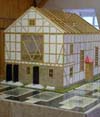
Judaica History Workshop
The goal of the History Workshop in the attic of the Rotenburg Jakob-Grimm-Schule, inaugurated in 2001, is to present the history of the relationship, with all its light and shade, between Jews and their non-Jewish environment in our home area. Among other things, the permanent exhibition shows models of the former Jewish ritual bath (mikvah) and of the Rotenburg synagogue, desecrated and devastated in November 1938. Also on display is the original tapestry with swastika-dominated Rotenburg of the 1930’s made by members of the local Nazi women’s organisation which was hanging, next to the pulpit, in the Rotenburg Jakobikirche (St. Jacob’s Church) from May 1935 until March 1945.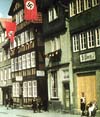
The Pogroms in November 1938 – A Farewell to Civilization
The very night of November 7, 1938, immediately after Hershel Grynspan had attacked Ernst vom Rath at the German embacy in Paris, there were violent excesses against the Jewish minority in Rotenburg and neighbouring Bebra. On November 9, 1938, in his infamous inflammatory speech, Nazi chief propagandist Goebbels praised the pogroms in our area as exemplary actions and thus initiated the pogroms on the night of November 9, 1938, the so-called crystal night. Over all, in Rotenburg 22 buildings, including the synagogue and the Jewish school, were heavily damaged in the period of November 7 till November 10, 1938.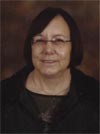
History of the Werthan Family
Ellen Stepak nee Goldenberg grew up in Huntington, Indiana, USA. After graduating from the University of Wisconsin/Madison, she made aliyah to Israel in September 1969. Since 1995 Ellen has been engaged in research of her ancestors from Pinsk, Belarus; Rotenburg an der Fulda, Germany (and in the US from 1854); Belozerka, Ukraine; Kupiskis and Vabalninkas, Lithuania and Lodz, Poland. Among her family surnames are Brenn, Posenitzky, Werthan, Gotthelf, Krukstein, Klots and Kling. She has translated material for the Internet, is writing family books, has helped document old Jewish cemeteries in Europe, and has written articles on genealogical topics. She is an active member of the Israel Genealogical Society. She is the wife of Zvi, mother of three and grandmother of two. In this book, which is here presented as a PDF, Ellen relates the story of her genealogical journey to discovering and researching her roots in the region of Hesse, Germany. It is a very different story from that of her other ancestors. Here the family resided in one place, even in one house, for generations, and she was able to visit inside the half-timbered family home, dating from before the 19th Century.
Biographies
Moritz Moses Berlein / Baruch Flörsheim / Chanan Hans Flörsheim / Ruth Gützlaff-Katzenstein / Herz Hess / Prof. Dr. Moritz Katzenstein / Siegfried Katzenstein / Theodor Döllefeld / Ilse Linz-Wischnia / Markus Linz / Dr. Leopold Neuhaus / Sophie Linz-Rosenfeld /Manfred Oppenheim (Moshe Naveh) / Dr. Siegfried Sommer / Ilse Yehudith Speier-Epstein / Moshe (Morris) Werthan / Joseph Wertheim / Hugo Wertheim /From here in alphabetical order
Alheim-Baumbach

Jewish Life in Alheim-Baumbach
The virtual tour of Baumbach takes you to the places of the former Jewish congregation and its members – by texts, documents, drawings, photos, and video clips. It conveys a graphic notion of more than two centuries of Jewish life and its destruction in a small village in the state of Hessen. There is a lengthy biographical chapter on Isfried Neuhaus whose family made it to the USA in 1933. The CD version can be ordered postage-free with the address given in the masthead of the website.
Alheim-Heinebach
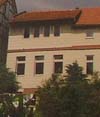
History of the Jews in Alheim-Heinebach (Sabine Häde)
You get a general overview of more than two centuries of Jewish life in a German village. Special attention is given to individual families. You find information about the synagogue which, in 1843, was converted of a former farmhouse. The painting in the ceiling of the former synagogue is the only memory of its usage as a place of worshipping. Sabine Haede’s treatise was written under the guidance of Professor Dietfried Krause-Vilmar of the University of Kassel who initiated quite a number of similar projects.
Biographies
Sally Katzenstein/Franz Korwan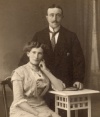
Julie Sommer
Julie Sommer was the mother of Ruth Holländer, Roger Herz-Fischler’s mother. She was born in Heinebach in 1886, as daughter of Sarah Katzenstein of Frankenberg and Koppel Sommer of Heinebach. In 1914 she married Joseph Holländer of Hilchenbach (near Siegen). Both Julie Sommer and Joseph Holländer were deported to Zamość, Poland in 1942, and there murdered. In 1937 their daughter Ruth was able to emigrate to the U.S. where she married Sigmund Fischler from Leipzig. In 1940 their son Roger was born in Washington Heights (located in the upper part of Manhattan), the home to twenty-five thousand German-Jewish refugees. What follows is divided into two parts. The first part contains material, in a very abbreviated form, from the chapters, “The Hilchenbach Group”, “Common Ancestors” and “Selma Holländer and Freddy Furcht” of Roger Herz-Fischler’s book A Triple Love Story / The Ancestors of Eliane Herz and Roger Fischler. The entire book, divided into chapters for convenience, can be found at either of the following two sites:https://people.math.carleton.ca/~rhfischl/GENEALOGY/GENEALOGY.html
http://web.ncf.ca/en493
The second part is a copy of the chapter (with the page numbering, etc. unchanged) “The Heinebach Group” from the book A Triple Love Story. The genealogical tree on the first page above shows the maternal ancestors of Julie Sommer through the great-grandparents. The tree on the first page of the second part shows the paternal ancestors of Julie Sommer through the great-grandparents. Since their retirement Eliane and Roger Herz-Fischler have written three books related to the history of their families.
Bad Hersfeld
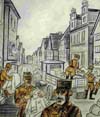
Stolpersteine für Bad Hersfeld
Right now we are devoting much of our time and energy to a project called "Stolpersteine" (=stumbling blocks) for former Jewish citizens of Bad Hersfeld. So far we have been able to install 43 such memorial stones, each costing 120 €uro. We are confident we can find sufficient sponsors for more of them which are meant to honor and remember those who lost their lives in the Holocaust. Almost all of these victims do not have a gravesite. As some sort of compensation a concrete cube that is covered in brass with the name of the victim and his or her fate is installed into the sidewalk in front of the person’s last known residence. "Stolpersteine are a metaphor for the Germans stumbling over this part of their past—something that won't go away—and that was the artist's point," says James E. Young of the University of Massachusetts at Amherst, author of two books on Holocaust memorialization. "Stolpersteine don't exist in places where you have to make your pilgrimage. You suddenly come upon them." With the stolpersteine everybody sees that things happened in their neighborhood. They realize that there were people who lived in their house or even in their apartment." "It's very important not to lose the remembrance of this special part of German history.
Crystal Night 1938 in Bad Hersfeld
The sound-animated slide-show of the infamous events in November 1938 are not meant as a dry historical documentation. The presentation rather aims at enabling young people, in particular, to find an approach to this part of German history. This is the main reason why the heavily involved Nazi stormtroopers and members of the SS are shown in their uniforms even though this is literally not correct. The idea of showing the culprits as organized Nazis wearing their uniforms is to unmask them as doubtless henchmen of the regime and to present the events of November 1938 as manipulated actions, thus correcting the Nazi leaders’ maintaining public anger as the reason for the outbreak of the November 1938 pogroms.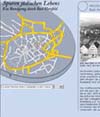
Following Jewish Tracks in Bad Hersfeld
The virtual tour of Jewish Hersfeld takes you to the places of the former Jewish congregation of Bad Hersfeld and its former Jewish citizens, by texts, documents, drawings, photos, and video clips. The project conveys a graphic idea of Jewish life and its destruction under Nazi rule in a Hesse town. After the abolishment of the settlement ban in 1867 Bad Hersfeld had, within two generations, become a centre of Jewish life in the eastern part of Hessen. There were quite a number of successful Jewish businessmen who, in the decades before World War I, had moved to Bad Hersfeld from neighbouring communities. On May 30, 1942 the last group of Hersfeld Jews were deported to Lublin in eastern Poland.In Preperation

Former Jewish pupils of “Alte Klosterschule” Grammar School from 1809 to 1937
You find the names of all Jewish pupils who attended the school which qualified for immatriculating at the university. The information gives the respective school attendance and a reference to the families of the pupils. There are biographies, of different length, of 12 former Jewish pupils who, for various reasons, arose particular interest. Special reference is made to those who became victims of the holocaust and to those who died as soldiers in World War I. You can order a multimedia CD produced by the ex-pupil Dr. Heinrich Nuhn in cooperation with the Konrad-Duden-Schule (now placed in the buildings of the former Alte Klosterschule). Its technical realisation was carried out by Pascal Dreher, Rotenburg/ Kassel.

Holocaust Victims
>>Ehem. Schüler des Gymnasiums Alte Klosterschule als Holocaustopfer
Bebra

In Front of Everybody/ Vor aller Augen – Bebra 1933 to 1941
National socialist terror was practised not only behind barbed wire, behind prison walls or in examination rooms of the Secret Police (Geheime Staatspolizei/ Gestapo). Brute force against minorities, in particular against citizens of Jewish belief and people of different ways of thinking also occurred in the streets and squares of German cities, towns and villages. Bebra was the first place after Kassel where as soon as the night of November 7, 1938 violent excesses took place which Nazi chief propagandist Joseph Goebbels in his inflammatory speech used to initiate the nationwide pogroms (“Crystal Night”) of November 1938. In this chapter you also find a documentation of actions against the local Jews prior to 1938. “In Front of Everybody/ Vor aller Augen” can be ordered postage free-via the address given in the masthead of this website.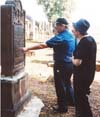
Bebra Jewish Cemetery (virtual tour)
Cemetries are often the only authentic evidence of formerly thriving Jewish life which was brutally destroyed by Nazi dictatorship. A place of remembrance of the extinguished Jewish minority can be found in the Otto-Kraffke-Strasse near Bebra town centre where it was laid out in 1869. Till then the Bebra Jews had to bury their deceased on the central Jewish Cemetery in Rotenburg on the Fulda. The first burial in Bebra was that of tradesman (“Handelsmann”) Honas Fackenheim who dies March 16, 1870 at the age of 78. On August 4, 1937 the Bebra town councillors decreed the closure of the cemetery, “for sanitary reasons”. The size of the cemetery is 1513 square metres. At its western side a warehouse marks its boundary. With its 100 tombstones the Bebra Jewish cemetery somehow conveys a notion of the role Jewish citizens played here an d what meaning they had for the modern history of the town. The texts on the headstones are given in Hebrew (original Hebrew text form plus transliteration), in English, and in German. A number of tombstones have been chosen to tell the respective family history and certain aspects of Bebra’s Jewish tradition which originates in the 17th century.
Biographies
Isidor Fackenheim/ Dr.med. Willy Fackenheim Louis Goldschmidt / Leopold Levi / Leo OppenheimBreitenbach am Herzberg

Biographies
Biographie xy (von Barbara Greve)Burghaun

Biographies
Manfred Braunschweiger/ F.M. Browning / Marga & Manfred Strauß (von Elisabeth Sternberg)Burghaun-Langenschwarz
Heringen
Haunetal-Rhina
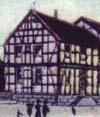
Short History of the Jewish Congregation (Abraham Frank)
Abraham Frank (Jerusalem) konnte in seiner Abhandlung auf hebräische Quellen und innerjüdisches Schriftgut zurückgreifen, die Einblicke in das Leben der Rhinaer Juden ermöglichten.
Haunetal-Wehrda
Hohenroda-Mansbach
Hünfeld

Biographies
Joseph Strauß (von Elisabeth Sternberg)Knüllwald-Rengshausen

Biographies
Nathan Höflich (Eckhard Preuschhof)
Holocaust Victims
Nentershausen
Biographies
Willy KatzNiederaula

Short History of the Jewish Congregation (Heidi Rößing)

Oberaula
Short History of the Jewish Congregation (Barbara Greve)
Jewish Cemetery (Barbara Greve)

Rotenburg on the Fulda


Following Jewish Tracks in Rotenburg on the Fulda
A guided tour of the town invites to pay a virtual visit to some aspects of the varied history of Jewish Rotenburg. Here is hardly any other place in the state of Hessen on which a higher formative Jewish influence can be found. This is the result of Rotenburg, with short interruptions, being a place of Jewish settlement from ca. 1300 and having one of the largest Jewish small-town congregations. The CD-ROM version can be ordered postage-free with the address givenin the masthead of the website.

The Rotenburg Jewish Cemetery
Information is given about Jewish burial rites and about all 346 tombs. The oldest tombstone dates from 1743. The cemetery, however, was set up in the century before, the oldest evidence is of 1682. Up to the late 19th century the Rotenburg Jewish cemetery served as central burial site for the Jews from a number of neighbouring Jewish places, such as Baumbach, Bebra, Breitenbach, Iba, Lispenhausen, Ronshausen, and partly, Rengshausen.
Jewish Museum in the former Rotenburg mikvah – a Place of Remembrance and Encounters
In the house of the ritual Jewish bath (mikvah) used as late as 1938 a basin for immersion of 1835, another one of the 17th century, and a separate shaft for cleansing the knives for the kosher slaughtering of animals and private dishes were recently excavated. On the upper floor of the small half-timbered house there is a documentation of six centuries of Jewish life in Rotenburg on the Fulda and its vicinity, set up under the motto “what has been left”.
Judaica History Workshop
The goal of the History Workshop in the attic of the Rotenburg Jakob-Grimm-Schule, inaugurated in 2001, is to present the history of the relationship, with all its light and shade, between Jews and their non-Jewish environment in our home area. Among other things, the permanent exhibition shows models of the former Jewish ritual bath (mikvah) and of the Rotenburg synagogue, desecrated and devastated in November 1938. Also on display is the original tapestry with swastika-dominated Rotenburg of the 1930’s made by members of the local Nazi women’s organisation which was hanging, next to the pulpit, in the Rotenburg Jakobikirche (St. Jacob’s Church) from May 1935 until March 1945.
The Pogroms in November 1938 – A Farewell to Civilization
The very night of November 7, 1938, immediately after Hershel Grynspan had attacked Ernst vom Rath at the German embacy in Paris, there were violent excesses against the Jewish minority in Rotenburg and neighbouring Bebra. On November 9, 1938, in his infamous inflammatory speech, Nazi chief propagandist Goebbels praised the pogroms in our area as exemplary actions and thus initiated the pogroms on the night of November 9, 1938, the so-called crystal night. Over all, in Rotenburg 22 buildings, including the synagogue and the Jewish school, were heavily damaged in the period of November 7 till November 10, 1938.
History of the Werthan Family
Ellen Stepak nee Goldenberg grew up in Huntington, Indiana, USA. After graduating from the University of Wisconsin/Madison, she made aliyah to Israel in September 1969. Since 1995 Ellen has been engaged in research of her ancestors from Pinsk, Belarus; Rotenburg an der Fulda, Germany (and in the US from 1854); Belozerka, Ukraine; Kupiskis and Vabalninkas, Lithuania and Lodz, Poland. Among her family surnames are Brenn, Posenitzky, Werthan, Gotthelf, Krukstein, Klots and Kling. She has translated material for the Internet, is writing family books, has helped document old Jewish cemeteries in Europe, and has written articles on genealogical topics. She is an active member of the Israel Genealogical Society. She is the wife of Zvi, mother of three and grandmother of two. In this book, which is here presented as a PDF, Ellen relates the story of her genealogical journey to discovering and researching her roots in the region of Hesse, Germany. It is a very different story from that of her other ancestors. Here the family resided in one place, even in one house, for generations, and she was able to visit inside the half-timbered family home, dating from before the 19th Century.
Biographies
Moritz Moses Berlein / Baruch Flörsheim / Chanan Hans Flörsheim / Ruth Gützlaff-Katzenstein / Herz Hess / Prof. Dr. Moritz Katzenstein / Siegfried Katzenstein / Theodor Döllefeld / Ilse Linz-Wischnia / Markus Linz / Dr. Leopold Neuhaus / Sophie Linz-Rosenfeld /Manfred Oppenheim (Moshe Naveh) / Dr. Siegfried Sommer / Ilse Yehudith Speier-Epstein / Moshe (Morris) Werthan / Joseph Wertheim / Hugo Wertheim /Schenklengsfeld

Sontra
„Kristallnacht“ 1938 (Julius Katz/ Dr. Ulrich Schneider)
Sontra-Diemerode

Biographies
Willy William Katz
In Preparation

